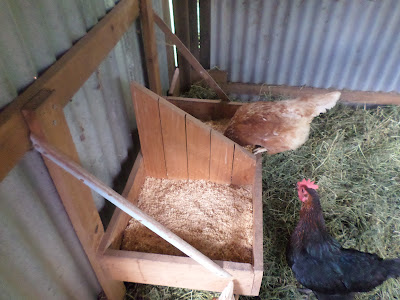Remember in part 1, when I said; "The beginning of all things, I'm convinced, are the relationships to all things. The ability to relate external substance, to our own". So it starts with us. However, it doesn't end with us. We have to connect with other living things, to evaluate any meaning to our own.
With only twelve of the daylight hours to interact in those relationships however, we have to make them count. They have to be in our face, obvious and enhancing to our daily lives. By developing a daily ritual of acknowledging those living things around us, we get a little boost of self-awareness. Which is really important if we live in a high stress environment, pulling us in all directions.
I'm fortunate, I can unplug from society on our property. But you know, I have little rituals for when I leave here, to go into town also. I pack a bag of home baked goodies, some fruit and cold drinks, chilled in a freezer bag with an ice brick. I can stop any time in my jobs, and have these treats to soothe me and those I'm travelling with. Getting out and stretching our legs is another important ritual when we go into town too. I always find a car park under shade (preferably a tree) and if it involves a walk to our destination, all the better.
But here's the biggie and it tops the list. We work together as a team and make sure everyone is comfortable. If someone needs help, we stop what we're doing and alternate our strategy to best meet the situation. Paying attention to details rather than purely meeting an objective, makes the difference between experiencing life or simply tolerating it.
Because that's where satisfaction can enter the equation. Satisfaction has the wonderful side-effect of making us feel happy, but we don't necessarily, have to be in an optimal situation all the time, to find satisfaction. It's about what we practice the most in our relationships though.
Which brings me to the summary of my series on relationships.
Hold someone's hand if you need to
.
1. Recognise how we translate relationships - connected or disconnected?
2. Learn how connected relationships work in nature. The permaculture principles and the community which supports them, are places to start learning from. If you're someone who struggles with human relationships (feeling vulnerable or excluded from them) engaging with nature, is that bridge to seeing how connected relationships work.
3. Look for ways to integrate nature into your daily life, even if you live in the city. This point alone, will increase your perspective - even if you don't get around to the first two steps.
4. Ask others around you, if they want to get involved with enhancing nature in your community. Even if its just adopting a few plants for the office. By inviting others to get involved, it helps the community become more self-aware also.
5. And probably the most important, is committing to the process like a loving relationship. You don't expect something to love you back, if all you give is your cold shoulder and a few indifferent glimpses of your time. Commitment doesn't have to mean physical torture, every day, either. It just means touching base in some way, every day - and actually missing it, when you've tuned out for too long.
6. Practice your commitment by supporting businesses which honour the autonomy (or natural cycles) of nature. This is not a prerequisite to following the above steps, but it can help shape the world we want to reflect our connected relationships in to.
7. Repeat above steps, until you don't recognise them as steps any more.
I haven't said much about point 6 yet, of practising your commitment by supporting other businesses. By spending where the autonomy of nature is respected, however, its the ultimate compliment we can pay our communities. Because it reflects the greater abundance of natural cycles, than the continual decline of man-made ones. These actions can accumulate and pay off over time, rather than running at a continual deficit today.
As individuals, families, communities and nations, we don't practice a unique identity, which is self-aware of our environment, as part of our culture any more. Instead, we focus only on the objective of "freedom" as a goal, with no defined responsibilities, other than what the law sets out. So its good to remind ourselves of the inclusive paradigm we're actually part of.
Perhaps Earth day is an attempt, to recognise we all need to collectively take part in something bigger than ourselves. Although, I feel its somewhat limited to one day, when a person can live a whole lifetime. So every day, should be indulging in connected relationships, with other living things.
There was a time, we didn't always know what things were called, or what their purpose was, before we found a connection with them. That is our ancestral language as a species. We connect, automatically, and we are drawn in, to respond to them.
So the question becomes, WHAT do we want to be drawn into, and how aware are we, in the process of that relationship? I hope, if nothing else, I've helped you think about your relationships a little more.














































